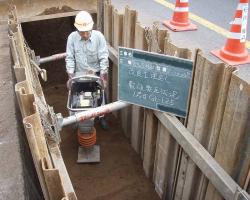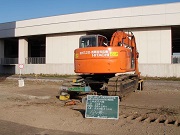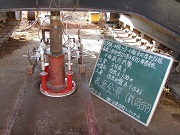- Yokohama-shi Top Page
- Living, procedures
- Community Development and Environment
- Rivers and sewers
- Sewer
- Efforts related to sewerage
- Effective use of sewage sludge
- Examples of effective use of improved soil using sewage sludge incineration ash
The text is from here.
Examples of effective use of improved soil using sewage sludge incineration ash
Last updated on April 3, 2024.
To date, Yokohama City has positioned sewage sludge incineration ash as a resource and has been effectively used for cement raw materials and bricks. The effective utilization rate for the total amount of incinerated ash generated was about 20% in fiscal 1990, but in fiscal 2004, the effective utilization rate was 100% due to the use of improved soil, continuing this.
1.Use as a backfill material for pipelines
In Motoichi, we actively use improved soil as a backfill material for sewer pipes, and the breakdown of the use of improved soil accounts for about 40% of the total (actual results at the end of 2008). In addition, in response to the damage situation of sewage pipes caused by the Niigata Chuetsu Earthquake, etc., we have evaluated the seismic performance of improved soil for backfilling, and we know that the improved soil for backfilling is less likely to liquefaction even during an earthquake.
 |  |
|---|
2.Use of building structures as direct foundation materials
In order to pioneer new use of the improved soil, scientifically examine and evaluate the use of the building structure as a direct foundation material (seismic foundation material) and construct it efficiently and effectively as a (seismic) foundation work. In fiscal 2008, the following tests were conducted for the purpose of We collected three improved soils (improved soil A to C) with different amounts of raw lime added manufactured at the improved soil center, and conducted various physical tests, tightening tests, single-axis compression tests, and three-axis compression tests (CD) indoors. Was. (Refer to test results 1) Next, as shown in the photo, a model plant was actually installed, where the solidification of the ground was changed (the number of rotations: 2, 4, 8 times) was compacted with various improved soil (A to C). After that, a flat plate loading test was conducted on the ground after tightening (see test results 3), samples that did not disturb the test ground were collected, and tests were conducted indoors (see test results 2).
|
|
|
|
|---|---|---|---|
| Pressure test 1 | Pressure test 2 | Test of flat plate loading 1 | Verification of plate loading test 2 |
Test Results
Improved soil A: Lime additive rate 15%, improved soil B: Lime additive rate 25%, improved soil C: Lime additive rate 35%
Test Results 1 (Indoor soil test results using improved soil disturbance samples) (PDF: 86KB)
Test Results 2 (Indoor soil test results using improved soil disturbance samples) (PDF: 90KB)
Test Results 3 (Results of test of flat plate loading of improved soil) (PDF: 79KB)
Summary of Test Construction
As can be seen from the physical test results in the room, the particle size distribution of the improved soil shows the distribution status averaged from gravel to clay, so that the rolling effect is likely to appear, and even with a small number of rolling pressures, it seems to have expressed sufficient support force as a supporting ground. The three-axis test results confirmed that there is a shear resistance angle of about 35°, and it is thought that the sandy soil is stronger than viscosity soil. In addition, based on particle size distribution and consistent test results, it is determined that the ground with improved soil will not be liquefied. The improved soil can be judged to be able to directly express sufficient support as a supporting ground for the foundation if appropriate formulation and rolling pressure are performed according to the conditions of the original soil. In actual construction work, we believe that it is necessary to conduct a plate loading test after completion of support ground conversion to confirm support capacity after conversion, but we believe that results that can be expected to be put into practical use in the future have been shown.
Examples of utilization
At present, we plan to use the improved soil as a direct foundation material for the construction of a sludge treatment facility separating and dewatering machine building under construction in Hokubu Sludge Treatment Plant. The construction period will begin in November 2009 (this year), and we plan to use approximately 8,000 m3.

You may need a separate PDF reader to open a PDF file.
If you do not have it, you can download it free of charge from Adobe.
![]() To download Adobe Acrobat Reader DC
To download Adobe Acrobat Reader DC
Inquiries to this page
Sewerage and Rivers Bureau Sewer Facilities Department Facility Management Section
Phone: 045-671-3965
Phone: 045-671-3965
Fax: 045-641-4870
E-Mail address [email protected]
Page ID: 946-285-911











